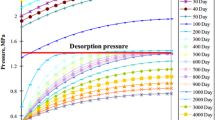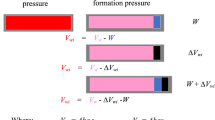Abstract
Drainage of formation water controls pressure dropping behavior of coalbed methane wells. Different behaviors indicate that formation water can be classified into two types. The first type is ineffective water, representing the water from aquifers of strong, extremely strong water yield property, or phreatic water. It is difficult to generate pressure dropping when this type of water is pumped. The other type is effective water, representing the water from aquifers of middle or weak water yield property. Pressure decline will occur if this type of water is pumped. Based on the modified Duipt equation, the production of effective water and the production percentage of ineffective water for well QNPN01 are calculated considering the variations of influence radius, absolute permeability, and relative water permeability. The results show that in the single water flow stage, the production of effective water and the production percentage of ineffective water drop in the zigzag way at first and then keep stable roughly. In the water–gas flow stage, the production of effective water decreases firstly and then keeps stable, while the production percentage of ineffective water increases firstly and then keeps stable. Furthermore, the production of effective water in unit pressure decline indicates that the process of pressure dropping can be divided into four stages. The first one is a single water flow stage in which pressure dropping completely depends on effective water. The second one refers to the beginning of a water–gas flow stage. In the stage, pressure dropping strongly depends on effective water. Pressure dropping caused by effective water drainage starts to be replaced by gas desorbing in the third stage, and completely replaced in the fourth stage.











Similar content being viewed by others
References
Chi WG (1998) Hydro-geological control on the coalbed methane in Qinshui basin. Petrol Exp Dev 25(3):15–18 (in Chinese with English abstract)
Deng Z, Kang YS, Liu HL, Li GZ, Wang B (2009) Dynamic variation character of coalbed methane reservoir permeability during depletion. J China Coal Soc 34(7):947–951 (in Chinese with English abstract)
Fu XH, Qin Y, Wei CT (2007) Coalbed methane geology. China University of Mining and Technology Press, Xuzhou (in Chinese)
George JD, Barakat MA (2001) The change in effective stress associated with shrinkage from gas deportation in coal. Int J Coal Geol 45:105–113
Gentzis T, Bolen D (2008) The use of numerical simulation in predicting coalbed methane producibility from the Gates coals. Alberta Inner Foothills. Canada: comparison with Mannville coal production in the Alberta Syncline. Int J Coal Geol 74:215–236
Gilman A, Beckie R (2000) Flow of coalbed methane to a gallery. Transport Porous Med 41:1–16
Gray I (1987) Reservoir engineering in coal seams: part I—the physical process of gas storage and movement in coal seams. SPE Reserv Eng 2(1):28–34
Harpalani S, Chen G (1993) Gas slippage and matrix shrinkage effects on coal permeability. In: Proceeding of the 1993 International Coalbed Methane Symposium, pp. 285–294
Harpalani S, Zhao X (1989) An investigation of the effect of gas desorption on coal permeability formation. Proceeding of Coalbed Methane Symposium, Tuscaloosa, pp 57–64
Hatta H, Shibuya K, Nishiyama Y, Kogo Y (2003) Analysis of gas leakage through C/C composites. Carbon 41:2831–2838
Kopp A, Binning PJ, Johannsen K, Helmig R, Class H (2010) A contribution to risk analysis for leakage through abandoned wells in geological CO2 storage. Adv Water Resour 33:867–879
McBeth IH, Reddy KJ, Skiner QD (2003) Coalbed methane product water chemistry in three Wyoming watersheds. J Am Water Resour Assoc 39(3):575–585
Palmer I (2009) Permeability changes in coal: analytical modelling. Int J Coal Geol 77:119–126
Palmer I, Mansoori J (1998) How permeability depends on stress and pore pressure in coalbeds: a new model. SPE Reserv Eval Eng 1(6):557–563
Peaceman DW (1978) Interpretation of well-block pressures in numerical simulation. SPE J Trans AIME 253:183–194
Rice CA (2003) Production waters associated with the Ferron coalbed methane fields, central Utah: chemical and isotopic composition and volumes. Int J Coal Geol 56:141–169
Rightmire CT, Eddy GE, Kirr JN (1984) Coalbed methane resources of the United States. The American Association of Petroleum Geologists, Tulsa
Scott AR, Kaiser WR (1995) Hydrogeologic factor affecting dynamic open-hole cavity complections in the San Juan Basin, U.S.A. Proceedings of the 1995 Coalbed Methane Symposium, the University of Alabama/ Tuscaloosa, pp. 139–147
Seidle JP, Huitt LG (1995) Experimental measurement of coal matrix shrinkage due to gas desorption and implications for cleat permeability increases. SPE Proceedings of the International Meeting on Petroleum Engineering, Beijing, pp 575–582
Seidle JP, Jeansonne DJ, Erickson DJ (1992) Application of matchstick geometry to stress dependent permeability in coals. Paper SPE 24361 presented at SPE Rocky Mountain Regional Meeting, Casper, Wyoming, pp. 18–21
Shi JQ, Durucan S (2004) Drawdown induced changes in permeability of coalbeds: a new interpretation of the reservoir response to primary recovery. Transport Porous Med 56:1–16
Shi JQ, Durucan S (2005) A model for changes in coalbed permeability during primary and enhanced methane recovery. SPE Reserv Eval Eng 8(4):291–299
Shi ZP (2002) A discussion of practical problems of obtaining parameters in hydrogeology. J Xi’an Univ Technol 18(1):84–87 (in Chinese with English abstract)
Snyder GT, Riese WC, Franks S, Fehn U, Pelzmann WL, Gordody AW (2003) Origin and history of waters associated with coalbed methane: 129I, 36Cl, and stable isotope results from the Fruitland Formation, CO and NM. Geochim Cosmochim Ac 67(23):4529–4544
Thararoop P, Karpyn ZT, Ertekin T (2012) Development of a multi-mechanistic, dual-porosity, dual-permeability, numerical flow model for coalbed methane reservoirs. J Nat Gas Sci Eng 8:121–131
Wang DC, Zhang R, Shi YH, Xu SZ, Yu QC, Liang X (1995) Hydro geology. Geological Publishing House, Beijing (in Chinese)
Wang HY, Zhang JB, Liu HL, Qin Y (2001) Hydrogeologic feature of coalbed methane reservoir in the southern Qinshui Basin. Coal Geol Explor 29(5):33–36 (in Chinese)
Wang X, Melesse AM, McClain ME, Yang W (2007) Water quality changes as a result of coalbed methane development in a Rocky Mountain watershed. J Am Water Resour Assoc 43(6):1383–1399
Wang XJ, Ward CR (2009) Experimental investigation of permeability changes with pressure depletion in relation to coal quality. 2009 International Coalbed Methane Symposium. University of Alabama, Tuscaloosa, Alabama, pp. 1–31
Wei CT, Qin Y, Wang GX, Fu XH, Jiang B, Zhang ZQ (2007) Simulation study on evolution of coalbed methane reservoir in Qinshui basin, China. Int J Coal Geol 72:53–69
Wei ZJ, Zhang DX (2010) Coupled fluid-flow and geomechanics for triple-porosity/dual-permeability modeling of coalbed methane recovery. Int J Rock Mech Min 47:1242–1253
Xu GM (2008) Permeation theory of underground water and its numerical simulation. Geological Publishing House, Beijing (in Chinese)
Xue YQ (1986) Dynamic theory of underground water. Geological Publishing House, Beijing (in Chinese)
Young GBC (1998) Computer modeling and simulation of coalbed methane resources. Int J Coal Geol 35:369–379
Zhang XM, Tong DK, Xue LL (2009) Numerical simulation of gas-water leakage flow in a two layered coalbed system. J Hydrodyn 21(5):692–698
Acknowledgements
The authors wish to acknowledge the following funding for the supporting of this study, they are the National Basic Research Program of China (no. 2009CB219605), Key Program of the National Science Foundation of China (no. 4073042), Key Program of the National Science and Technology (no. 2008ZX05034-04), and the National Science and Technology Major Project (no. 2011ZX05034-005).
Author information
Authors and Affiliations
Corresponding author
Rights and permissions
About this article
Cite this article
Zou, M., Wei, C., Zhang, M. et al. A mathematical approach investigating the production of effective water during coalbed methane well drainage. Arab J Geosci 7, 1683–1692 (2014). https://doi.org/10.1007/s12517-013-0957-7
Received:
Accepted:
Published:
Issue Date:
DOI: https://doi.org/10.1007/s12517-013-0957-7




